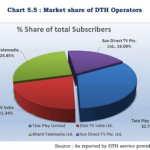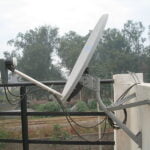Both GTPL and IMCL don’t completely agree with TRAI and recommended some changes in the draft regulations released by TRAI on 27th August about Broadcasting and Cable Services Interconnection Regulations.
Clause C-1 of that draft states that the distributor of television channels shall ensure that the current version of the CAS, do not have any history of hacking and a written declaration available from the CAS vendor.
Commenting on this clause GTPL said that the Authority needs to consider and address the usage of legacy CA Systems by various distributors. For such CA Systems, a written declaration of the distributor should suffice. GTPL asked TRAI to prescribe a reasonable time period for phasing out such legacy CA Systems.
IMCL and GTPL both commented on clause C-4 which says that the distributor of television channels shall validate that the CAS, in use, do not have facility to activate and deactivate STB directly from the CAS terminal and all activation and deactivation of STBs shall be done with the commands of the SMS.
GTPL agreed with this clause and said that such facility though present in the CAS shall not be used by the distributor for a purpose other than testing and the same shall be certified by the distributor.
IMCL said that CAS systems enable operators to activate/deactivate STBs from the CAS terminal and this feature enables CAS operators to test the system. It is a process that is implemented within a DPO to ensure that only those commands which are sent via SMS system are processed by the CAS.
Adding further to this IMCL said that DPOs must demonstrate that they have a process for ensuring that the SMS is integrated with the CAS, any activations/deactivations done via the CAS are logged including indication which user ID was used for such activities so that it can be assessed by auditors.
Clause C-5 states that SMS and the CAS should be integrated in such a manner that activation and deactivation of STB happen simultaneously in both the systems. GTPL replied saying that there is always a system lag of a few minutes and asked the Authority to acknowledge this.
Section (C) clause 6 prescribes that The distributor of television channels shall validate that the CAS has the capability of upgrading STBs over-the-air (OTA).
GTPL asked TRAI to modify this clause as the term OTA is mostly applicable for DTH operators while cable operators use over the cable (OTC) for such functions. GTPL also asked to add OTC in clause E-10 and F-6 also where only OTA is mentioned as the software update method.
IMCL replied that The CAS is not the only device that can send the OTA to the STBs. IMCL is using PSI/SI server and it says that this ensures a common method for sending OTA irrespective of the CAS being used. IMCL added that it is complying with DAS regulations 2012 in which there was no requirement for the CAS to deliver the OTA to the STBs.
IMCL said that this clause in Unnecessary and puts limitations on DPOs on delivering OTAs in other acceptable methods which neither affect security or have any service impact. They requested TRAI to remove this clause.
In clause C-10 GTPL asked TRAI to replace the term “subscriber” by “STB” because that CAS contains data of STB and VC only not subscriber. The clause says that CAS and SMS should be capable of individually addressing subscribers, for the purpose of generating the reports.
Clause F-7 states that the DRM and the SMS should be able to activate/deactivate services or STBs of at least 10% of the subscriber base of the distributor within 24 hours. GTPL suggested that the requirement of activation/deactivation of services be limited to 5% as mandated in clause C (8) of Schedule III.
STB should have a provision that fingerprinting is never disabled, says clause D-13. GTPL asked for clarification over this clause that its applicability should be only during the power-on mode. It suggested to change the clause and make fingerprinting necessary only when STB is in power-on mode.
Both GTPL and IMCL objected Clause D-12 which mandates that scroll messaging should be only available in the lower part of the screen. They said that this feature is not possible to be implemented for certain legacy STBs as their vendors are not in business and hence unable to give any support for upgrades.
IMCL recommended TRAI to make this clause applicable only for those STBs that are purchased by any DPO post-March 2017 because QOS regulation was released that month.
GTPL, on the other hand, asked TRAI to exclude those STBs from this clause which were installed before 2019 as The new regulatory regime was notified on 3rd July, 2018 which required scroll messaging to be implemented.
Clause C-18 stated that distributor shall ensure that the CAS and SMS vendors have the technical capability in India to maintain the systems on a 24×7 basis throughout the year. GTPL that these systems are managed by vendors and some of those vendors are based outside India so they cannot have technical capacity inside India. GTPL asked TRAI to remove the term “in India” from this clause.
Clause C-15 mandates that CAS shall be able to tag and blacklist VC numbers and STB numbers that have been involved in piracy. GTPL asked to replace the term “CAS” with “SMS” in this clause as this feature is available on SMS, not CAS.
In the clauses C-14 and C-16, it is suggested that the CAS shall be independently capable of generating, recording, maintaining logs, and reports from those logs. GTPL said that some legacy STB push generated reports/logs on a predefined interval into a secured storage server so authority should replace the term “generating” with “available”.
Clause C-12(a) & 12(c) says that SMS should also be capable of generating, viewing and printing of historical data in terms of the activations/deactivations of STBs and changes in the subscriptions for each subscriber. GTPL said that historical data from all subscribers will put stress on them. They suggested TRAI a sample size of 5% of the active sub base for platforms having more than 5 Lakh average active subscribers while for platforms which have a lesser active subscriber base the sample size can be 25%.
IMCL asked for details on Section (E) clause 9 which states that the STB must be compliant to the applicable Bureau of Indian Standard (BIS). IMCL asked TRAI to mention whether this means that each STB model must be certified by the BIS specifically, or just a self-certification of compliance is sufficient.








